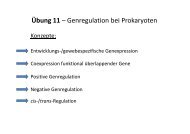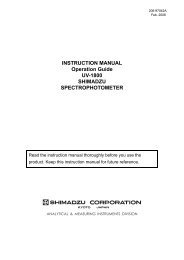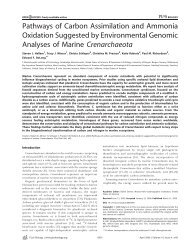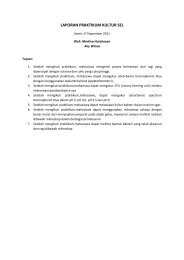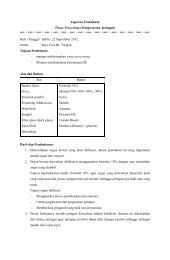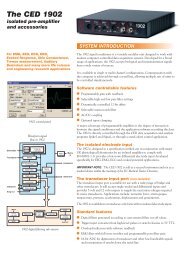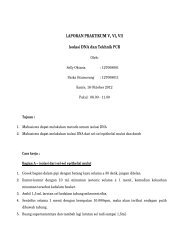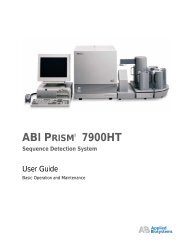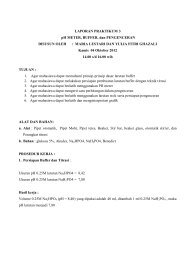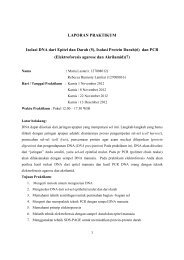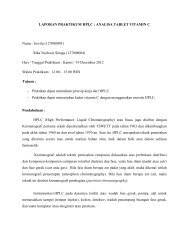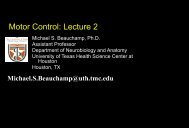Lab Chore Protocols - OpenWetWare
Lab Chore Protocols - OpenWetWare
Lab Chore Protocols - OpenWetWare
You also want an ePaper? Increase the reach of your titles
YUMPU automatically turns print PDFs into web optimized ePapers that Google loves.
Prather <strong>Lab</strong> <strong>Chore</strong> <strong>Protocols</strong><br />
Updated December 17, 2008<br />
<strong>Chore</strong>s in the Prather lab are shared tasks performed on a rotating basis. You are<br />
expected to pay attention to the lab’s chore sheet and to perform the various lab chores in<br />
a timely manner when it’s your turn. This document provides instructions for performing<br />
all of the lab chores.<br />
Disposing of Aspirator Waste<br />
Aspirator waste should be disinfected and disposed of when the aspirator flask contains<br />
about 900-1000 mL of liquid.<br />
1. Remove the plug from the top of the aspirator and set it aside. Disconnect the<br />
aspirator flask from any tubing. Move the flask to a location where you can easily<br />
work with it.<br />
2. Disinfect the aspirator waste by adding pure bleach (found in the cabinets<br />
underneath the lab’s main sink) to a final dilution of 1:10 directly into the<br />
aspirator flask. Swirl the flask to mix. Let the flask sit for 20-30 minutes. The<br />
bleach should be added even if the flask contents are clear.<br />
3. Pour the disinfected contents of the flask slowly down the lab’s main sink and<br />
flush with plenty of water.<br />
4. Add about 100 mL of bleach to the empty flask.<br />
5. Reconnect the flask to the vacuum pump and re-plug the flask.<br />
Autoclaving Biological Waste<br />
Waste from the white biohazard waste bins must be autoclaved before disposal.<br />
Biological waste must be autoclaved for extended periods of time (~90-180 minutes) to<br />
ensure its sterility. Because treating biological waste requires extensive use of the<br />
autoclave (which is shared by several labs), it is more polite to only autoclave waste in<br />
the evenings or on weekends.<br />
1. Close the large, clear biological waste bags with cable ties. It’s a good idea to fill<br />
up any less-than-full bags with any full, small, clear biowaste bags from the<br />
benches.<br />
2. Fill out and tie an “Autoclaved Biological Waste” white tag around the neck of<br />
the bag.
3. Take the biological waste bags to the autoclave room (56-415).<br />
4. Fill out the “autoclave log sheet” in the autoclave room (the one that asks for the<br />
autoclaved waste bag tag numbers).<br />
5. Set the autoclave to dry and make sure the temperature is set to 121 o C. Set the<br />
sterilization and drying times to the following:<br />
Number Sterilization Drying<br />
of Bags Time (min) Time (min)<br />
1 90 20<br />
2 105 20<br />
3 120 20<br />
4 130 20<br />
5 140 20<br />
6 145 20<br />
7+ 150 20<br />
6. Let the autoclave run. Be sure to let the autoclave depressurize before removing<br />
your trash bags. Note that it is ok to let the autoclave run overnight, as long as<br />
you pick up your waste the next day.<br />
7. Remove the waste bags from the autoclave and discard them in the lab’s normal<br />
(not biological) trash bins.<br />
Note: Call EHS at 2-3477 to request additional autoclave bag tags (white).<br />
Disposing of Biological Sharps Bins<br />
The biological sharps bins are picked up and disposed of by EHS every Thursday.<br />
1. Push any pipets or other waste down into the container, such that nothing is<br />
sticking out above the rim of the bin.<br />
2. Close the bin by pulling the bin’s cover all the way over the top of the bin.<br />
3. Use two cable ties to seal the bin’s cover. Holes for cable ties are found on one<br />
side of the cover.<br />
4. Send an email to biosharps@mit.edu no later than Tuesday evening with the<br />
following information:<br />
• Your Name<br />
• Your Contact Information (Phone and Email)<br />
2
• <strong>Lab</strong>’s Building and Room Number (66-425)<br />
• Number of Biosharps Bins to be Collected<br />
If you send them an email on Wednesday there is still a good chance they will<br />
pick up the bins, but not always.<br />
5. On Wednesday evening place the filled, sealed biosharps bin(s) out in the<br />
hallway.<br />
6. On Thursday, EHS will come by to remove the filled bin(s). They will only come<br />
by if you sent them an email on Tuesday (or earlier). When they remove the<br />
filled bins they will replace them with empty ones. EHS can come by anytime<br />
between 7:30am and 5:00pm to pick up the filled bins.<br />
7. Move the new empty bins into the lab and place them in the lab appropriately.<br />
Decontaminating the Ethidium Bromide (EtBr) Waste<br />
The EtBr waste should be decontaminated when the 5L EtBr waste container (found at<br />
the gel station in the lab) is 90-95% full. When treating the EtBr waste, wear the<br />
appropriate personal protective equipment (gloves, safety glasses, lab coat) and be very<br />
careful not to get any of the waste on your skin or to splash any of it on the benchtop.<br />
EtBr, as a DNA-binding molecule, is a strong mutagen. Be sure to change gloves if they<br />
get wet with EtBr waste and before going back to other labwork. Try not to spread EtBr<br />
around the lab.<br />
Currently, the lab uses the Extractor EtBr System from Whatman. From the company’s<br />
website:<br />
The Extractor EtBr System is a one-step filtration funnel device for the rapid removal of ethidium<br />
bromide from gel-staining solutions.<br />
This disposable unit contains an activated carbon matrix, which removes > 99% of ethidium bromide from<br />
electrophoretic buffer quickly and easily. Each device can decontaminate up to 10 liters of gel-staining<br />
solution. After filtration, the decontaminated solution can be safely poured down the laboratory drain.<br />
The extractor funnel device fits most standard laboratory flasks and bottles (neck size 33 to 45 mm), and<br />
the unit includes a cap for storage between uses. the polypropylene housing is chemically resistant to<br />
organics. also included in the package are glass fiber prefilters, which remove gel pieces and other debris to<br />
avoid premature clogging of the carbon filter.<br />
1. Obtain an EtBr filtration funnel and two white prefilter disks from the cabinets<br />
underneath the sink near the gel station. If there is a partially-used EtBr filtration<br />
funnel be sure to use that one. Also find a 1L Erlenmeyer flask. Place these<br />
items near the vacuum pump, or bring the pump over the gel station on a cart.<br />
3
2. Disconnect the aspirator from the vacuum pump. Using vacuum tubing (not the<br />
clear tubing), connect the vacuum pump to the EtBr filtration funnel. Place the<br />
funnel on top of the 1L flask. Place one of the prefilter disks on top of the black,<br />
activated carbon inside the filtration funnel. The orientation of the filter disk<br />
(face up or face down) does not matter.<br />
3. Fill the EtBr filtration funnel with EtBr waste and turn on the vacuum pump. You<br />
may need to pipet the first ~500 mL of waste from the 5L waste container to<br />
avoid spilling if the container is too full to pour.<br />
4. Allow the vacuum to draw the liquid through the filter. Repeat step 3 until the 1L<br />
flask is full.<br />
5. Flush the contents of the 1L flask (the decontaminated liquid) down the sink with<br />
plenty of water.<br />
6. Repeat steps 3-5 until all of the EtBr waste is decontaminated and disposed of.<br />
You will notice that the more liquid you treat, the slower the liquid will flow<br />
through the filter.<br />
• If the liquid flow rate becomes very slow, replace the prefilter. Used<br />
prefilters should be disposed of in the black chemical waste bucket.<br />
• If changing the prefilter does not improve the filtration rate, replace the<br />
entire EtBr filtration funnel. Dispose of the used funnel in the chemical<br />
waste bucket.<br />
7. Place the empty 5L EtBr waste container back at the gel station. Disconnect the<br />
vacuum tubing from the funnel and reconnect the aspirator.<br />
8. On the side of the EtBr filtration funnel, check off the volume of waste that you<br />
treated (typically 5L for a full waste container). Each filtration unit has the<br />
capacity to decontaminate 10L of waste. If the unit you are using has reached<br />
10L, dispose of it in the chemical waste bucket.<br />
4



